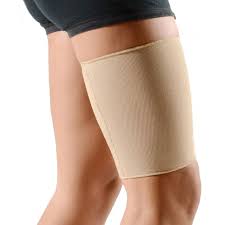Introduction
In the world of physical support products, thigh braces have gained attention for their role in aiding muscle recovery, providing injury prevention, and offering support for a range of activities. For those who are physically active or recovering from an injury, a thigh brace can be an essential tool. Whether you’re a runner, a weightlifter, or simply someone who experiences frequent thigh muscle strain, a thigh brace might help enhance performance, reduce pain, and prevent further damage. This guide delves into what thigh braces are, their uses, benefits, and tips for choosing the best one for your needs.
What is a Thigh Brace?
A thigh brace is a supportive garment designed to wrap around the upper leg, providing compression, warmth, and stability to the thigh muscles. Thigh braces come in various forms—some are sleeves, others have adjustable straps, and some even incorporate advanced materials for added support. These braces can be made from neoprene, elastic, or other fabrics that are stretchable yet firm. They are used in sports, physical therapy, and day-to-day wear to offer support, reduce pain, and protect the muscles and ligaments in the upper leg.
Types of Thigh Braces
- Compression Sleeves
Compression sleeves for the thigh provide uniform pressure around the leg. They are generally easy to slip on and are used mainly for muscle support and circulation improvement. They are popular among athletes and people who need mild to moderate support. - Adjustable Wraps
These braces come with straps or Velcro, allowing users to adjust the tightness according to their needs. Adjustable wraps offer more support than simple compression sleeves, making them suitable for people recovering from a thigh injury. - Hamstring Braces
Specific thigh braces are designed to target the hamstrings. These are ideal for people who have experienced hamstring pulls or strains and need extra stability in the back of the thigh. - Thigh and Groin Support Braces
Some braces are designed to support both the thigh and groin. These are typically bulkier but provide comprehensive support, especially for individuals recovering from groin injuries or muscle tears in the upper thigh.
Benefits of Using a Thigh Brace
- Injury Prevention
Thigh braces reduce the risk of injury by providing additional stability to the upper leg muscles. Athletes, particularly those engaged in sports involving sprinting or sudden directional changes, can benefit significantly from wearing a thigh brace to prevent common injuries like strains, sprains, and tears.
- Enhanced Recovery
For individuals recovering from a thigh injury, wearing a thigh brace can speed up the healing process. Compression and support help reduce inflammation, maintain muscle alignment, and stimulate blood flow to the injured area, which can promote faster recovery.
- Pain Relief
Thigh braces help alleviate pain by compressing the affected area, reducing swelling, and offering warmth to sore muscles. This is particularly beneficial for individuals with chronic pain from conditions like arthritis or tendonitis.
- Improved Performance
For athletes, a thigh brace can improve overall performance. By stabilizing the muscles and keeping them warm, the brace reduces the risk of strain, allowing athletes to push harder with reduced risk of injury.
- Increased Circulation
Compression increases blood flow to the muscles, which helps with recovery, reduces cramping, and improves muscle endurance during prolonged physical activities.
Common Injuries Addressed by Thigh Braces
- Hamstring Strains
Hamstring injuries are common in sports involving high-speed running. A thigh brace, especially one that supports the back of the thigh, can be essential for recovery and protection against re-injury. - Quadriceps Strains
This type of injury is common in high-impact sports and can cause pain in the front of the thigh. A thigh brace provides support to the quadriceps, reducing strain on the muscle. - Groin Pulls
A groin pull affects the inner thigh muscles. Some thigh braces extend to the groin area, providing additional support and helping alleviate pain. - IT Band Syndrome
The iliotibial (IT) band runs along the outer thigh. Braces that offer lateral support can help reduce pain associated with IT band syndrome, which is especially common among runners. - Thigh Contusions
Thigh bruises, or contusions, can occur from contact sports. A thigh brace provides cushioning and reduces impact, making it ideal for recovering from a contusion.
How to Choose the Right Thigh Brace
When selecting a thigh brace, consider factors such as your specific needs, material preference, comfort level, and budget. Here are some key points to help you make an informed decision:
- Purpose of the Brace
- Determine if you need the brace for injury recovery, daily use, or sports performance enhancement.
- If you are recovering from an injury, opt for a brace with adjustable compression and higher support.
- Material and Comfort
- Look for materials that are durable, breathable, and suitable for your level of activity.
- Neoprene provides excellent compression and warmth but may feel hot if you are in warm climates or engage in high-intensity sports.
- Elastic or Lycra materials are more lightweight and breathable, making them ideal for extended wear.
- Level of Compression
- Some braces offer firm compression, while others are looser. Choose a brace that provides adequate pressure without restricting blood flow.
- If you are new to wearing thigh braces, start with moderate compression and gradually adjust as you get used to the support.
- Size and Fit
- Thigh braces come in various sizes, so it’s essential to measure your thigh and select a size that fits well.
- A brace that is too tight can restrict circulation, while a loose brace may not provide sufficient support.
- Design and Adjustability
- If you need varying levels of compression, consider braces with adjustable straps.
- Adjustable braces are more versatile and can be adapted as your thigh heals or as your activity levels change.
- Cost and Quality
- High-quality braces can be more expensive but often provide better durability and support.
- Decide on a budget that suits you and consider the long-term value of investing in a reliable brace.
Tips for Wearing a Thigh Brace
- Follow Instructions
Ensure you wear the brace according to the manufacturer’s instructions to maximize its benefits and avoid unnecessary pressure on your muscles. - Check for Comfort and Fit
Adjust the brace as needed to avoid discomfort, especially if you plan to wear it for long periods or during intensive physical activity. - Wear During High-Impact Activities
Wear the brace during activities where your thigh muscles are under significant strain, such as running, lifting weights, or playing contact sports. - Wash Regularly
Most thigh braces can be hand-washed to maintain hygiene and prolong the life of the material.
Conclusion
A thigh brace is a valuable tool for anyone seeking support, pain relief, and injury prevention for their upper leg muscles. With numerous types, materials, and designs available, it’s essential to choose a brace that fits your needs and lifestyle. Whether you’re an athlete recovering from an injury, a fitness enthusiast, or someone experiencing thigh discomfort in daily life, a thigh brace can provide stability, aid recovery, and improve your overall comfort and performance.









